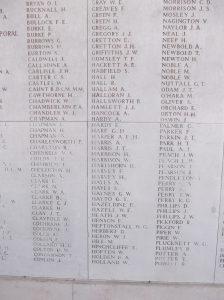Today we were privileged to be visiting the Menin Gate to remember George Henry Hare of Dunsby who was killed exactly 100 years ago on this date, 31st July 1917, on the first day of the Battle of Passchendaele. George being the author’s Gt Gt Uncle.
George was born in Dunsby, Lincolnshire, in the summer of 1895, to John Hare, a farm Horseman born in Wigtoft and his wife Sarah Sharpe born in Pinchbeck. John and Sarah were married in 1882 and had 12 children, unfortunately loosing 3 of their children before 1911.
Their married life started in Pinchbeck, quickly moving to Quadring and eventually settling in Dunsby in 1884 where their remaining children were born.
Mary Jane Hare, 1882, Pinchbeck
Elizabeth Hare, 1883, Quadring
William Sharp Hare, 1884, Dunsby
John Hare, 1887, Dunsby
Charles Hare, 1888, Dunsby
Walter Hare, 1890, Dunsby
Alice Hare, 1892, Dunsby
George Henry Hare, 1895, Dunsby
Ethel May Hare, 1896, Dunsby
George found work as a farm labourer and was living at home in Dunsby fen aged 16 in 1911.
George enlisted into the army in Bourne and was posted to the 15th Battalion Sherwood Foresters (Notts and Derby Regiment). This was a bantam Battalion made up of men under 5 feet 3 inches typically from mining or agricultural backgrounds. Although they were ordered to Egypt in late 1915, this was cancelled and their first overseas posting was in February 1916 to France where the Battalion fought in the Battle Somme
George was posted to the 16th Battalion Sherwood Foresters, although it is not known exactly when this occurred. Typically a wounded soldier would upon regaining fitness, after a period of time, be posted to a Battalion where they were most in need of replacements.
We can be sure that George was with the 16th Battalion in his final month as their diary mentions a new draft on the 15th June but none since.
The 16th had move from the Ancre area of France in November 1916 into the Ypres Salient. Here they remained until the end of June 1917 when they were moved from the Hilltop Sector near the Ypres-Yser Canal, to Northern France. Once in Serques the Battalion underwent training in preparation for the big attack planned for the Ypres Salient.
On the 21st / 22nd of July George along with his 16th Battalion, were moved by Motor Lorries and Motor Busses close to Poperinge and then marched to a rest camp near Wornhoudt. They remained bivouaced here until the 27th July.
The next day they were moved back to their old stomping ground of the Hill Top Sector relieving the 6th Lincolnshires.
The following is an extract from the Battalion Diary describing their movements in the lead up and on the first day of the Battle of Passchendaele.
30th July – Hill Top Sector
The Battalion Assembled in our own front line trenches to assault the German Trenches and capture their front line system. A Company on the right front and B Company on the left front wire detailed to capture and consolidate the German front (red) and support (yellow) lines. Whilst C Company on the left passed through and went forward to capture and consolidate the German reserve line (Blue and Dotted Blue lines). The 11th battalion, the Royal Sussex Regiment were on our right and 17th Battalion King’s Royal Rifle Corps on our left.
31st July – Hill Top Sector
At 3.50am the artillery barrage opened and our four lines advanced to get as close under it as possible. The men followed closely and the objectives assigned to the Battalion were secured with little difficulty by A Company commanded by Captain C G Lord, B Company commanded by Captain P H Coleridge, C Company Commanded by Captain L H Askwith and D Company by Lieutenant T C O Williams.
The enemy held these trenches lightly and only put up a weak resistance. During the advance the Battalion captured 120 prisoners and 2 machine guns. Advanced Battalion Headquarters were established in Camphor Trench (Reserve Line) and the consolidation of the Dotted Blue Line commenced.
At 8.30am A Company was withdrawn for work under the 227th Field Company Royal Engineers for road construction.
During the day the greater part of the Battalion was employed in carrying forward the Brigade dump and carrying forward SAA bombs, wire and water to the 17th Battalion Sherwood Foresters and 16th Battalion Rifle Brigade who had captured Kitchener’s Wood and the trench system up to the River Steenbeek.
At 4.30pm C Company was sent up to reinforce the 17th Battalion Sherwood Foresters and came under command of the Officer Commanding that battalion. One Platoon of this Company was sent forward to the line of the River Steenbeck.
About 9pm B Company was similarly sent up to reinforce this line 2nd Lieutenant A S Mellor was wounded whilst conducting a camping party to Kitchener’s Wood.
At some point between Assembling in Hornby and Forward Trench at Zero minus 3 and the end of the first day of the Battle of Passchendaele (3rd Battle of Ypres), Private George Henry Hare was killed in action.
Commonwealth War Graves Commission:
In Memory of Private George Henry Hare, 33949, 16th Battalion, Sherwood Foresters (Notts and Derby Regiment) who died on 31 July 1917 Age 21.
Remembered with Honour Ypres (Menin Gate) Memorial
Panel Ref: Panel 39 and 41
George is also commemorated on the war memorial in his native Parish Church in Dunsby, Lincolnshire.
“their name liveth for evermore”




Recent Comments